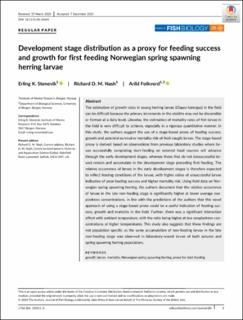Development stage distribution as a proxy for feeding success and growth for first feeding Norwegian spring spawning herring larvae
Journal article, Peer reviewed
Published version

Åpne
Permanent lenke
https://hdl.handle.net/11250/2730810Utgivelsesdato
2020Metadata
Vis full innførselSamlinger
- Department of Biological Sciences [2213]
- Registrations from Cristin [9465]
Sammendrag
The estimation of growth rates in young herring larvae (Clupea harengus) in the field can be difficult because the primary increments in the otoliths may not be discernible or formed at a daily level. Likewise, the estimation of mortality rates of fish larvae in the field is very difficult to achieve, especially in a rigorous quantitative manner. In this study, the authors suggest the use of a stage‐based proxy of feeding success, growth and potential survival or mortality risk of field‐caught larvae. The stage‐based proxy is derived based on observations from previous laboratory studies where larvae successfully completing start‐feeding on external food sources will advance through the early development stages, whereas those that do not (unsuccessful larvae) remain and accumulate in the development stage preceding first feeding. The relative occurrence of larvae in the early development stages is therefore expected to reflect feeding conditions of the larvae, with higher ratios of unsuccessful larvae indicative of poor feeding success and higher mortality risk. Using field data on Norwegian spring spawning herring, the authors document that the relative occurrence of larvae in the late non‐feeding stage is significantly higher at lower average zooplankton concentrations, in line with the predictions of the authors that this novel approach of using a stage‐based proxy could be a useful indication of feeding success, growth and mortality in the field. Further, there was a significant interaction effect with ambient temperature, with the ratio being higher at low zooplankton concentrations at higher temperatures. This study also suggests that these findings are not population specific as the same accumulation of non‐feeding larvae in the late non‐feeding stage was observed in laboratory‐reared larvae of both autumn and spring spawning herring populations.
